Evaluating the Rheological and Tribological Behaviors of Coconut Oil Modified with Nanoparticles as Lubricant Additives
Abstract
:1. Introduction
2. Materials and Methods
2.1. Nano-Lubricants Preparation
2.2. Rheometer
2.3. Tribological Characterization
2.4. Surface Characterization
3. Results
3.1. Morphology
3.2. Rheological Properties of Nanofluids
3.3. Rheological Models
3.3.1. Power Law Model
3.3.2. Cross Model
3.4. Tribological Results
3.5. Worn Surface Characterization
4. Conclusions
- Nano-lubricant rheological behavior is dependent of concentration. For SiO2 nanoparticles in coconut base oil, viscosity increased at higher concentrations. For CuO nanoparticles, the viscosity decreased as the concentration of CuO increased in coconut base oil.
- Friction-reduction properties of coconut oil were enhanced by the addition of SiO2 and CuO nanoparticles.
- There exists an optimum concentration of CuO nanoparticles (0.5%) at which the coefficient of friction is the least.
- As the SiO2 nanoparticle concentration increases, the COF decreases up to a 1.25% concentration.
- Surface analyses via SEM and profilometry confirmed the surface enhancement of the worn surfaces via the polishing effect produced by the nanoparticle additives.
Author Contributions
Funding
Conflicts of Interest
References
- Darminesh, S.P.; Sidik, N.A.C.; Najafi, G.; Mamat, R.; Ken, T.L.; Asako, Y. Recent Development on Biodegradable Nanolubricant: A Review. Int. Commun. Heat Mass Transf. 2017, 86, 159–165. [Google Scholar] [CrossRef]
- Thottackkad, M.V.; Perikinalil, R.K.; Kumarapillai, P.N. Experimental Evaluation on the Tribological Properties of Coconut Oil by the Addition of CuO Nanoparticles. Int. J. Precis. Eng. Manuf. 2012, 13, 111–116. [Google Scholar] [CrossRef]
- Alves, S.M.; Barros, B.S.; Trajano, M.F.; Ribeiro, K.S.B.; Moura, E. Tribological Behavior of Vegetable Oil-Based Lubricants with Nanoparticles of Oxides in Boundary Lubrication Conditions. Tribol. Int. 2013, 65, 28–36. [Google Scholar] [CrossRef]
- Mobarak, H.M.; Mohamad, E.N.; Masjuki, H.H.; Kalam, M.A.; Al Mahmud, K.A.H.; Habibullah, M.; Ashraful, A.M. The Prospects of Biolubricants as Alternatives in Automotive Applications. Renew. Sustain. Energy Rev. 2014, 33, 34–43. [Google Scholar] [CrossRef]
- Jayadas, N.H.; Nair, K.P. Coconut Oil as Base Oil for Industrial Lubricants—Evaluation and Modification of Thermal, Oxidative and Low Temperature Properties. Tribol. Int. 2006, 39, 873–878. [Google Scholar] [CrossRef]
- Lee, K.; Hwang, Y.; Cheong, S.; Choi, Y.; Kwon, L.; Lee, J.; Kim, S.H. Understanding the Role of Nanoparticles in Nano-Oil Lubrication. Tribol. Lett. 2009, 35, 127–131. [Google Scholar] [CrossRef]
- Peng, D.X.; Kang, Y.; Hwang, R.M.; Shyr, S.S.; Chang, Y.P. Tribological Properties of Diamond and SiO2 Nanoparticles Added in Paraffin. Tribol. Int. 2009, 42, 911–917. [Google Scholar] [CrossRef]
- Che Sidik, N.A.; Alawi, O.A. Computational Investigations on Heat Transfer Enhancement Using Nanorefrigerants. J. Adv. Res. Des. 2014, 1, 35–41. [Google Scholar]
- G02 Committee. Test Method for Ranking Resistance of Materials to Sliding Wear Using Block-on-Ring Wear Test; ASTM International: West Conshohocken, PA, USA, 2017. [Google Scholar] [CrossRef]
- G02 Committee. Test Method for Wear Testing with a Crossed-Cylinder Apparatus; ASTM International: West Conshohocken, PA, USA, 1996. [Google Scholar] [CrossRef]
- Ghasemi, R.; Fazlali, A.; Mohammadi, A.H. Effects of TiO2 Nanoparticles and Oleic Acid Surfactant on the Rheological Behavior of Engine Lubricant Oil. J. Mol. Liq. 2018, 268, 925–930. [Google Scholar] [CrossRef]
- Dwyer-Joyce, R.S.; Sayles, R.S.; Ioannides, E. An Investigation into the Mechanisms of Closed Three-Body Abrasive Wear. Wear 1994, 175, 133–142. [Google Scholar] [CrossRef]
- Trezona, R.I.; Allsopp, D.N.; Hutchings, I.M. Transitions between Two-Body and Three-Body Abrasive Wear: Influence of Test Conditions in the Microscale Abrasive Wear Test. Wear 1999, 225–229, 205–214. [Google Scholar] [CrossRef]
- Kahlman, L.; Hutchings, I.M. Effect of Particulate Contamination in Grease-Lubricated Hybrid Rolling Bearings. Tribol. Trans. 1999, 42, 842–850. [Google Scholar] [CrossRef]
- Chang, L.; Zhang, Z.; Breidt, C.; Friedrich, K. Tribological Properties of Epoxy Nanocomposites: I. Enhancement of the Wear Resistance by Nano-TiO2 Particles. Wear 2005, 258, 141–148. [Google Scholar] [CrossRef]
- Peng, D.X.; Chen, C.-H.; Kang, Y.; Chang, Y.P.; Chang, S.Y. Size Effects of SiO2 Nanoparticles as Oil Additives on Tribology of Lubricant. Ind. Lubr. Tribol. 2010, 62, 111–120. [Google Scholar] [CrossRef]
- Peng, D.X.; Kang, Y.; Chen, S.K.; Shu, F.C.; Chang, Y.P. Dispersion and Tribological Properties of Liquid Paraffin with Added Aluminum Nanoparticles. Ind. Lubr. Tribol. 2010, 62, 341–348. [Google Scholar] [CrossRef]
- Lee, C.G.; Hwang, Y.J.; Choi, Y.M.; Lee, J.K.; Choi, C.; Oh, J.M. A Study on the Tribological Characteristics of Graphite Nano Lubricants. Int. J. Precis. Eng. Manuf. 2009, 10, 85–90. [Google Scholar] [CrossRef]
- Arumugam, S.; Sriram, G. Synthesis and Characterization of Rapeseed Oil Bio-Lubricant Dispersed with Nano Copper Oxide: Its Effect on Wear and Frictional Behavior of Piston Ring–Cylinder Liner Combination. Proc. Inst. Mech. Eng. Part J J. Eng. Tribol. 2014, 228, 1308–1318. [Google Scholar] [CrossRef]
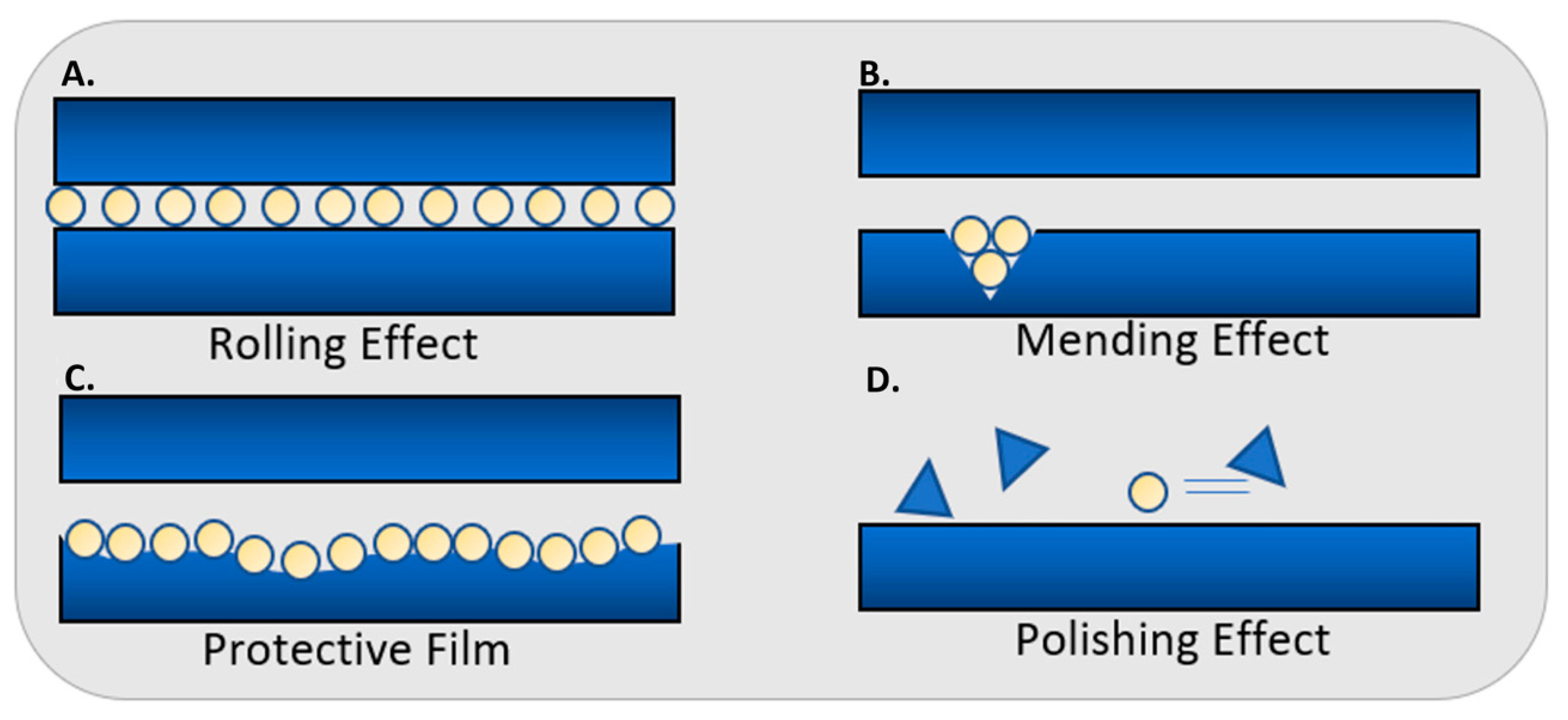
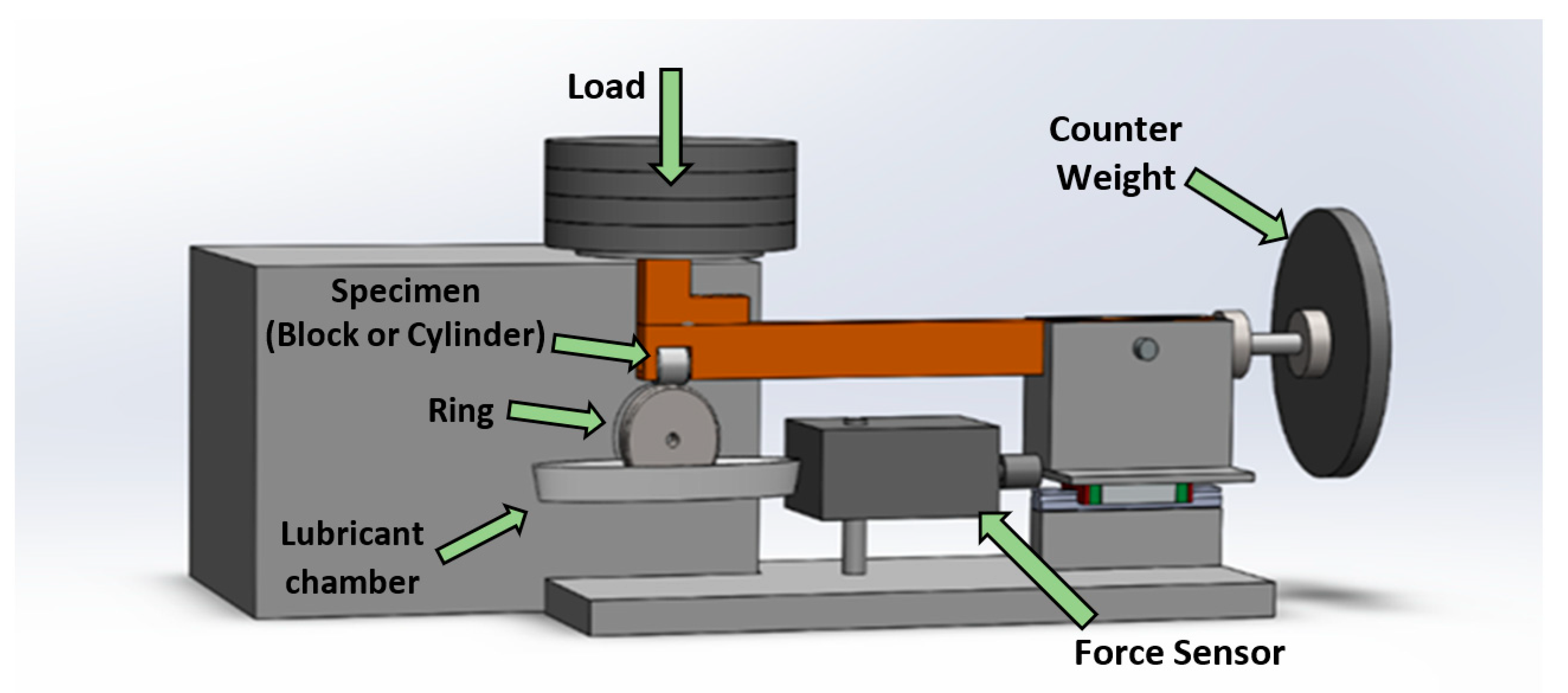


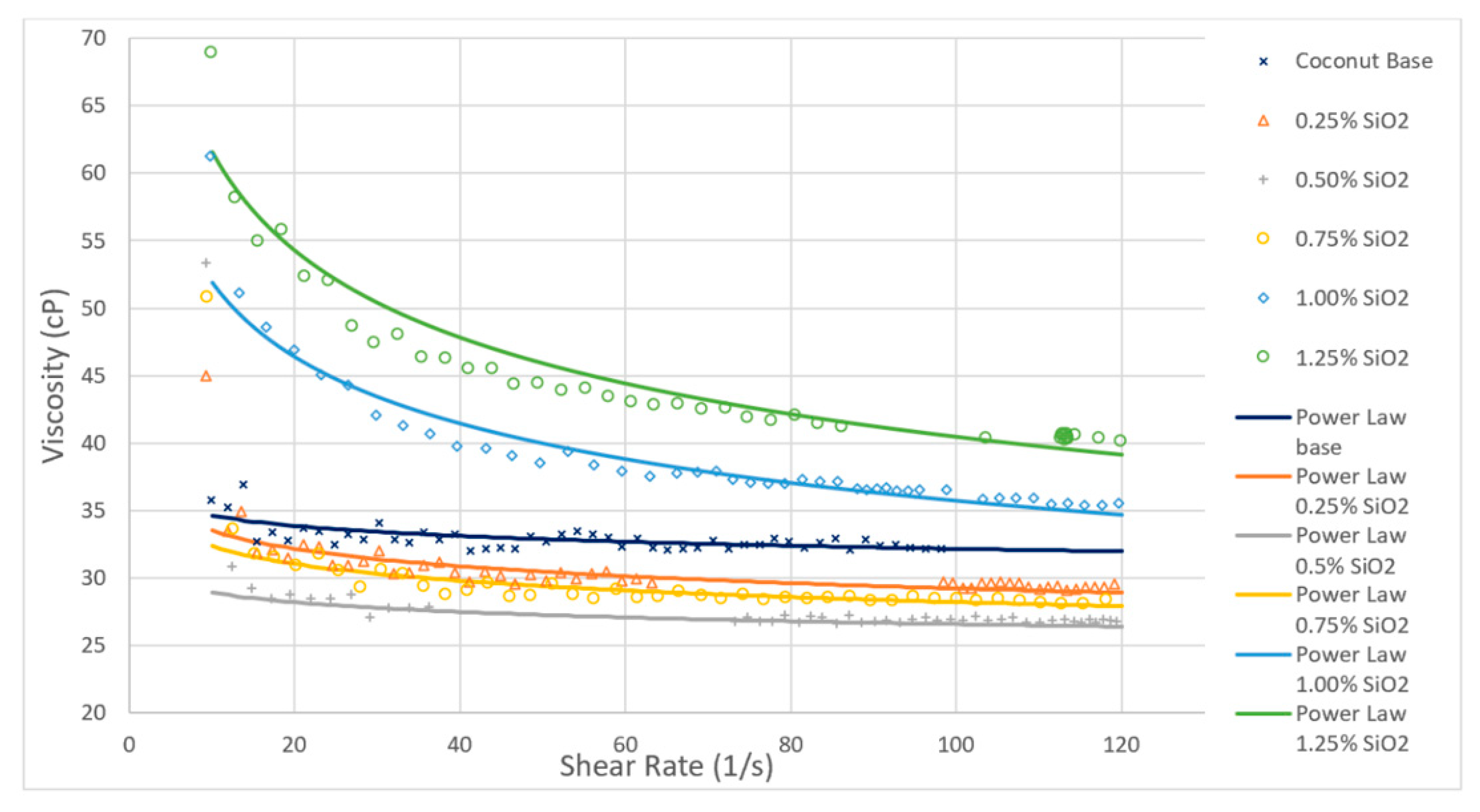
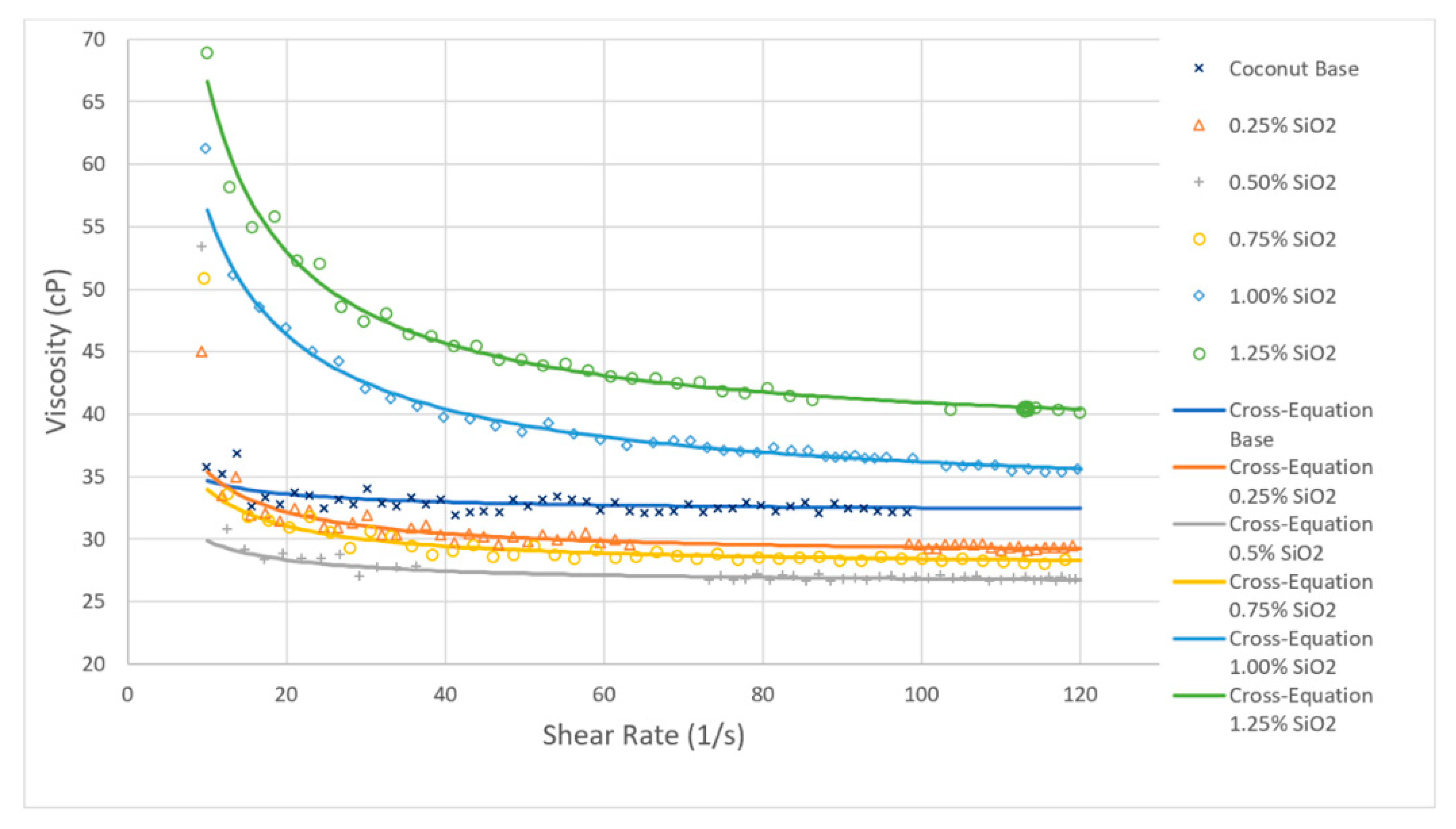

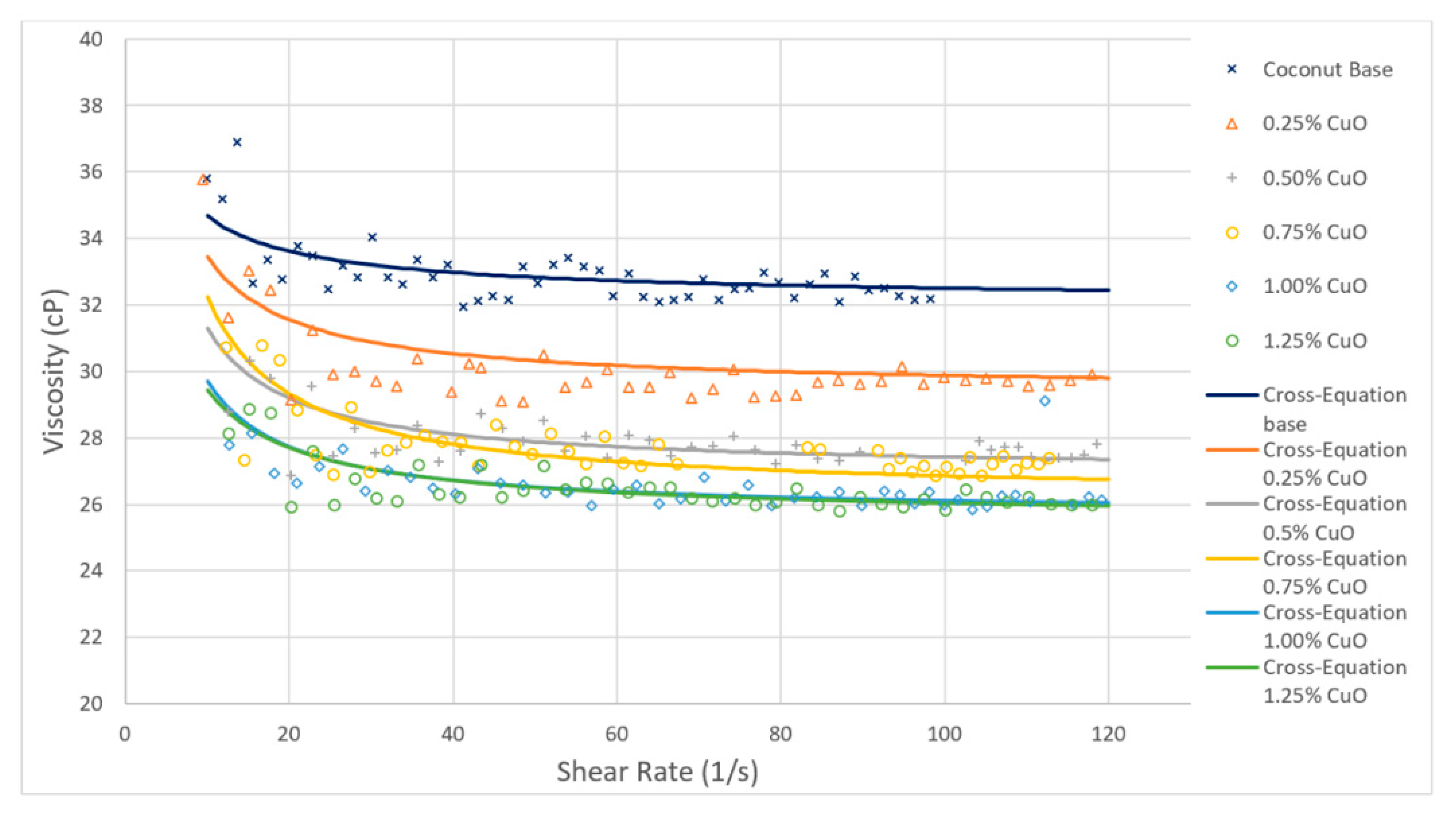

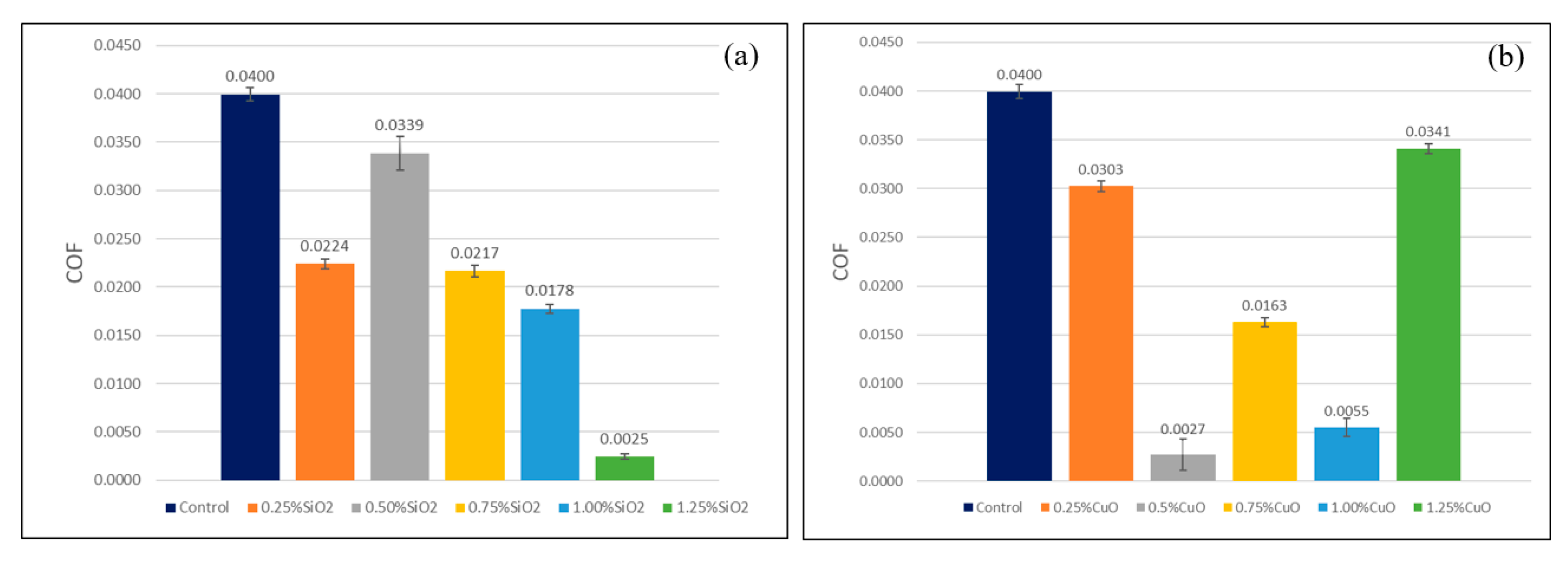


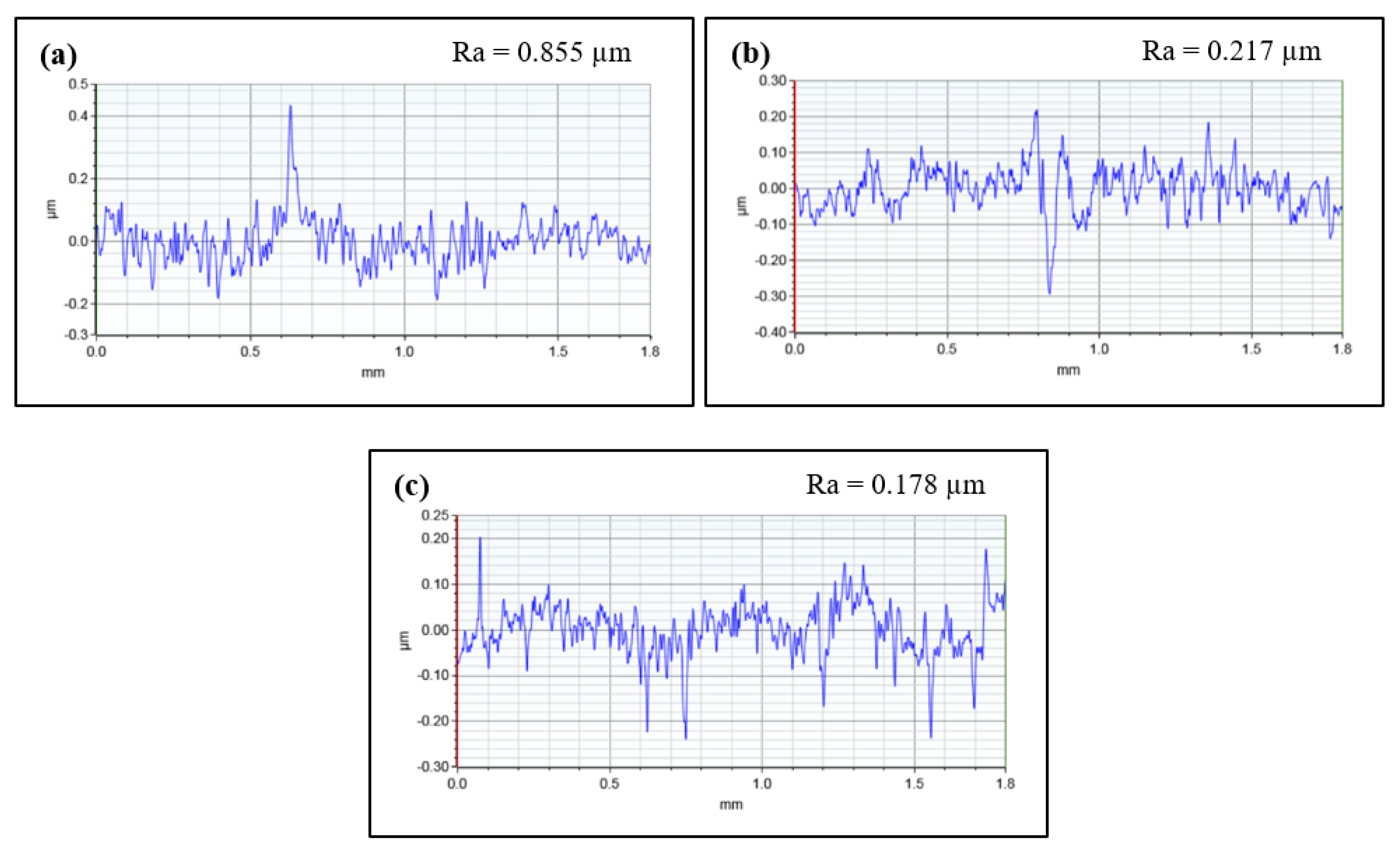
| Material | Properties |
|---|---|
| Lubricant | |
| Coconut oil | Density (40 °C): 0.92 g/cm3 Viscosity (40 °C): 26 mPa·s |
| Nanoparticles | |
| Silicon dioxide | Chemical formula: SiO2, Purity: 99.5% Particle size: 20–30 nm |
| Copper oxide | Chemical formula: CuO, Purity: 99% Particle size: 30–40 nm |
| Specimens | |
| Blocks | AISI 304 steel, dimensions: 14 × 6.35 × 6.35 mm, hardness: 128 HRB |
| Cylinders | AISI 304 steel, d = 12.7 mm, l = 14 mm, hardness: 60 HRC |
| Rings | AISI 52100 steel, d = 40 mm, hardness: 60 HRC |
| Model | Configuration | K | n | R2 | η0 | η∞ | RSME | SSE |
|---|---|---|---|---|---|---|---|---|
| Power Law | Coconut Oil w/1.25% SiO2 | 93 | 0.8174 | 0.9192 | N/A | N/A | 1.748 | 116.1 |
| Cross Equation | Coconut Oil w/1.25% SiO2 | 271.1 | 0.9029 | 0.9841 | 370 | 37.27 | 0.7658 | 22.87 |
| Power Law | Coconut Oil w/1.00% CuO | 31.01 | 0.9619 | 0.3370 | N/A | N/A | 0.8914 | 527.7 |
| Cross Equation | Coconut Oil w/1.00% CuO | 12.69 | 0.9847 | 0.4055 | 500 | 25.7 | 0.8426 | 471.7 |
© 2019 by the authors. Licensee MDPI, Basel, Switzerland. This article is an open access article distributed under the terms and conditions of the Creative Commons Attribution (CC BY) license (http://creativecommons.org/licenses/by/4.0/).
Share and Cite
Cortes, V.; Ortega, J.A. Evaluating the Rheological and Tribological Behaviors of Coconut Oil Modified with Nanoparticles as Lubricant Additives. Lubricants 2019, 7, 76. https://doi.org/10.3390/lubricants7090076
Cortes V, Ortega JA. Evaluating the Rheological and Tribological Behaviors of Coconut Oil Modified with Nanoparticles as Lubricant Additives. Lubricants. 2019; 7(9):76. https://doi.org/10.3390/lubricants7090076
Chicago/Turabian StyleCortes, Vicente, and Javier A. Ortega. 2019. "Evaluating the Rheological and Tribological Behaviors of Coconut Oil Modified with Nanoparticles as Lubricant Additives" Lubricants 7, no. 9: 76. https://doi.org/10.3390/lubricants7090076
APA StyleCortes, V., & Ortega, J. A. (2019). Evaluating the Rheological and Tribological Behaviors of Coconut Oil Modified with Nanoparticles as Lubricant Additives. Lubricants, 7(9), 76. https://doi.org/10.3390/lubricants7090076





